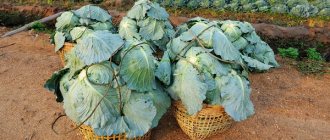All varieties of cabbage are healthy in their own way and can diversify the winter menu by adding vitamins to it. But how to store cabbage at home so that it lasts until spring and does not spoil?
The shelf life of cabbage depends on many factors. First of all, this is, of course, a variety. Agricultural technology, soil, harvesting timing, and the chosen storage method are also important. Not all gardeners follow the basic rules that allow you to enjoy fresh cabbage 8-10 months after harvest.
General rules for storing cabbage
After harvesting from the ridges, contaminated cabbage heads are washed with running water and inspected for slugs, worms and other pests. Forks are placed in a shaded, ventilated place. Dry the cabbage for no more than a day.
Healthy, strong heads of cabbage that are free of stains are placed for winter storage. The upper leaves are not cut off; they serve as protection from the external environment. If the top leaves have been subjected to the first frost, cut them off and discard them.
Inspect the stalk; it should be dense, without black spots inside or mechanical damage on the outside.
Preliminary preparation
Forks of late varieties of cabbage intended for long-term storage must be removed in time. Ripe heads of cabbage are collected in warm weather. They are carefully dug up and cleaned; the stalk should be preserved.
They are then sorted by size and checked for damage. Small and damaged heads are used first.
Covering leaves must be removed from forks selected for storage and placed under a canopy.
Optimal conditions
The room plays a significant role. You can preserve fresh cabbage for the winter by preparing the room:
- Temperature within +1-2°C.
- Get rid of possible pests - rodents, insects.
- Whitewash the walls.
- Clean and ventilate the room.
- Organize ventilation.
Neighborhood with other products
At home, it is hardly possible to store cabbage alone in the cellar, since in the fall the beds delight their owners with other vegetables, and fruit trees with fruits. Therefore, you need to create comfortable conditions for the cabbage, place it away from other crops at a maximum distance.
Prohibited:
- Place with other vegetables.
- Store diseased heads of cabbage next to healthy ones.
General storage conditions for cabbage
The place for storing cabbage is cool, relative humidity 70-80%, temperature +2 +5°C. The room must be dry, without groundwater, with mandatory ventilation. A cellar, basement, balcony or unheated attic space is suitable for this purpose. When storing cabbage in a dry, warm room, the head of cabbage will dry out. When the temperature drops below 0°C, cabbage leaves, which are 80% water, will freeze.
Useful tips
There are many small tricks that affect the safety of forks. In general, they allow you to get a “second” harvest in the spring. Here are some of them:
- heads of cabbage intended for storage should not be thrown away;
- any dent or crack may indicate the onset of a disease;
- an unknown variety does not need to be stored;
- Medium-sized heads of cabbage are best stored;
- diseases are transmitted not only through contact of vegetables, but also through the air.
By following these rules, you can eat fresh produce from your garden all year round.
Storing cabbage in the cellar
Almost every house has a cellar, and in multi-storey buildings there is a basement. Of course, this is the best place to store vegetables; they maintain the necessary microclimate. There are several time-tested methods that will keep cabbage fresh until spring.
In cling film
For this method, cling film is used. Under no circumstances should you use polyethylene; it creates excess moisture and prevents air access. The head of cabbage should be wrapped tightly, on all sides, in 2-3 layers. The stalk should be left at the level of the upper leaves. Make sure that there is no air left under the film. Then the head of cabbage is placed on a wooden rack or hung in a bag.
In boxes
If you have tall wooden boxes in your basement, they are ideal for storing cabbage heads. Thick cardboard is laid at the bottom of the boxes, and the cabbage is laid no higher than 2 layers. This method cannot be called ideal, because when the cabbage leaves come into contact with each other, they become wrinkled, moisture spreads, and the vegetable spoils. But for a couple of months the cabbage will stay in the boxes perfectly.
In paper
Cabbage can be wrapped in thick paper or 2-3 layers of newspaper. With this method, the heads of cabbage are placed on the top shelf in the cellar (basement), with the stalk of the head of cabbage lowered down. By ensuring a distance of 20 cm between the forks, you can preserve cabbage for up to 3 months.
In bags
There are many types of bags for storing vegetables sold in stores; they differ in the size of the bag itself and the size of the cells. For cabbage, you can use both fine-mesh and coarse-mesh mesh, the main thing is that the bags can withstand the weight. Cabbage in bags (nets) is laid out on shelves or on the floor, using wooden pallets for stands.
In sand
To store cabbage in sand, do not remove the roots during harvesting. Cabbage heads are placed in boxes with sand, burying them with their roots down. The sand is compacted tightly, but not watered, otherwise the cabbage will sprout and crack.
Tying up the heads of cabbage
The method our ancestors used. The heads of cabbage are tied together with hemp rope, two at a time, and hung on nails or hooks on the walls. This method is suitable for those cellars (basements) with dry walls. Additional protection from moisture will be cotton fabric, cardboard or newspaper, which is placed between the heads of cabbage and the wall.
Features for Beijing
Chinese cabbage is very sensitive to temperature. Depending on environmental conditions, its shelf life will differ:
- At +20 degrees and above – 24-36 hours.
- At a temperature of -3...+3 degrees – 14 days.
- In the freezer – 3 months or more.
Chinese cabbage is very demanding on air humidity. This figure must be at least 95%. Otherwise, the leaves begin to rot quickly.
Storing cabbage in the apartment
If the apartment does not have a basement, you can use the balcony if the air temperature is not lower than 2°C. To do this, the balcony must be covered and insulated. You can store cabbage on the balcony by wrapping it in cling film or newspapers. Place cabbage heads up in cardboard boxes with holes for air ventilation. Thick fabric is placed on top of the box. But what if you don't have a basement or balcony? Start preserving cabbage.
Pickling
Salt cabbage in sterilized glass jars. Chop cabbage and carrots into a container. Prepare the brine: add salt, sugar, and spices to taste to the water. Salt/sugar ratio 2:1. Cabbage is placed in jars for 2-3, filled with cold brine. Leave the cabbage in a cool place for 2-3 days. In this form, jars of cabbage are stored on the balcony or in the refrigerator. Shelf life - 2 months.
Pickling
Cut the cabbage into small squares, add chopped carrots. For red cabbage lovers, you can add chopped beets. For brine, take 2 parts sugar, 1 part salt, 5-6 allspice. The brine is boiled, after boiling, add 1 tbsp. 9% vinegar, pour hot brine over the cabbage and put under pressure. After 24 hours, the pickled cabbage is ready and can be stored in the refrigerator for 2 months.
Pickling
The process of sauerkraut differs from pickling in that during pickling, jars of cabbage are left in a warm room in the apartment for 2-3 days. During the fermentation process, liquid will begin to release and increase. In order not to spoil the floor covering, the jars can be placed in a basin or tall pan. During fermentation, hydrogen sulfide with an unpleasant odor accumulates in the jar. Pierce the cabbage with wooden sticks to allow the gas to escape, otherwise the cabbage will be slightly bitter. As soon as the release of water stops, the cabbage has fermented. It is transferred to a cold place for subsequent storage.
Freezing
Freezing the product will help keep cabbage fresh without resorting to preservation. The stalk of the cabbage is cut out, and the pieces of cabbage are placed in plastic bags. In this form, the vegetable can be stored for up to 1 year, but re-freezing cabbage is not recommended. Using this method of storing cabbage, all vitamins and beneficial microelements are preserved.
In vacuum bags
A method of preserving vegetables that is gaining popularity in the modern world. Pieces of cabbage are placed in special bags, and the air is removed from the bags using a vacuum pump. The vacuum storage method guarantees the safety of cabbage leaves for up to six months, storage on the top shelf of the refrigerator or in boxes on the balcony.
How long can it be stored, and how can I extend it?
Refrigerator conditions are not ideal for long-term storage of fresh cabbage. Without damage, it can be kept for no more than a month if there is no packaging on it , and spoiling leaves are periodically removed from it.
Proper packaging can extend the shelf life of a product. In film, healthy, dense heads of cabbage can last for several months, provided that there is enough space in the refrigerator to store supplies.
When packaged this way, white cabbage retains its flavor and crunch. Despite careful wrapping, such cabbage should be inspected periodically.
Freezing vegetables significantly extends the storage period by several months . This storage method can be used both for fresh cabbage and for stewed or fermented cabbage.
If storage conditions are not met, the vegetable will begin to deteriorate within a few days.











